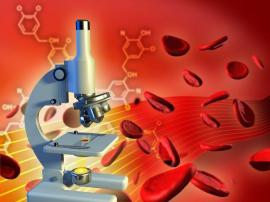In the competence of a Hematologist are the following directions:
- Study of the clinical signs of pathology of blood and bone marrow;
- The study of blood serum and plasma properties;
- Disease prevention forming organs;
- Diagnosis and treatment of various blood diseases;
- Development of new methods of diagnosis.
Symptoms, in which you need to immediately contact a specialist:
- bleeding wounds, cuts, their long healing;
- constant tiredness, weakness;
- the emergence of strong sweating;
- bruising at a slight injury;
- decrease in hemoglobin levels in the blood;
- swollen lymph nodes;
- frequent colds, a bad cough, sore throat.
Diseases which treats hematologist can be divided into two groups: leukemias and anemias. The most commonly diagnosed diseases:
- Iron-deficiency anemia;
- Aplastic anemia;
- Hemoblastoses;
- Acute leukemia;
- Chronic leukemia;
- lymphosarcoma;
- Increased bleeding;
- Hemophilia.
Diagnostics
In order to establish a correct and accurate diagnosis in hematology necessarily, the following blood tests:
- mieloramma (is investigated the cellular composition of bone marrow puncture),
- blood count (determined the number of red blood cells, platelets and white blood cells, hemoglobin and red blood cell indices).
Mandatory in the diagnosis of hematologic diseases are blood tests to identify the group and Rh factor. The result determined using the identification antibodies and antigens.
Prevention
The most important and effective preventive method of hematological diseases nature is a healthy lifestyle. The preventive measures, which are used in the treatment of hematological diseases also include: diet, medication with a high content of vitamins and minerals, anticoagulant therapy, intramuscular injections of B vitamins, especially B12, blood transfusion (for prevention and treatment of anemia), phlebotomy (at elevated level of iron in the blood), therapeutic phlebotomy.
Treatment
Since in hematology all diseases are very different, each of them requires a special approach and individual treatment system. Such systems are being designed by a hematologists for each patient individually.
The most modern method - the treatment of hematological diseases Positron emission tomography. In the body of a patient administered positron emitters, which for one - two hours propagate through the body, and in the following hour scanner captures on monitor all incoming data on the state of blood.
The methods of treatment of hematological diseases include chemotherapy and radiotherapy, bone marrow transplantation.
Almost all of the methods of treatment of diseases are associated with blood stem cells. The most common methods of bone marrow transplants - are allogeneic and autologous transplantation.
hide
 Hematologist - professionals involved in the diagnosis of diseases of blood and blood-forming organs, treatment and prevention of these diseases.
Hematologist - professionals involved in the diagnosis of diseases of blood and blood-forming organs, treatment and prevention of these diseases. 






